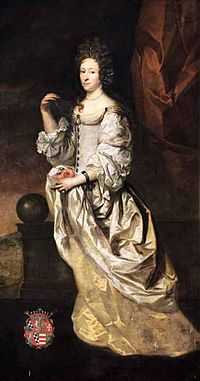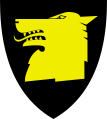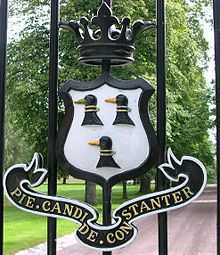Norwegian heraldry
 Norway's national arms are among the world's oldest national arms still in use. Official drawing of 1992 by Sverre Morken. | |
| Heraldic tradition | German-Nordic |
|---|---|
| Governing body | King |
Norwegian heraldry has roots in early medieval times, soon after the use of coats of arms first appeared in continental Europe. Some of the medieval coats of arms are rather simple of design, while others have more naturalistic charges. The king-granted coats of arms of later times, were usually detailed and complex. Especially in the late 1600s and the 1700s, many ennobled persons and families received coats of arms with shields containing both two and four fields, and some even with a heart shield above these.
There are very few civic arms dating from before 1900, and the main part of today's governmental and civic arms are from the last decades of the 20th century. Today the public arms are popular in Norway and they are used quite much by the official authorities.
The Norwegian Heraldry Society is a private heraldic organisation.
Private heraldry and coats of arms

History
Coats of arms, and the use of them, evolved on the battle fields in early medieval times. Intended for simple and immediate identification of the person inside the armour, the first arms were of rather basical design.
The king-granted personal arms of later times, were detailed and complex. Especially in the late 1600s and the 1700s, many ennobled persons and families received coats of arms with shields containing both two and four fields, and some even with a heart shield above these.
While the arms of the old nobility were of ancient origin and inherited through generations within each family, and therefore were not a particular privilege from the king, the arms of the new (post-medieval) nobility were often granted by the king upon ennoblement. In some cases, the ennobled person's former coat of arms or his wishes could be regarded in the process of composing new arms and thereto belonging achievements.
Noble heraldic privileges
The Norwegian nobility had no real heraldic privileges, as it was allowed for all citizens to assume their own coats of arms. In letters patent to the nobility, however, it was expressly granted a legal protection for their new arms. After 1814 there has been no such granting of nobility and arms in Norway.
Unlike in Sweden, the use of open helmets was not reserved for the nobility. Coronets and supporters were formally reserved for the nobility, but they were used also by a number of others, without any protests from the public authorities. Supporters were normally granted to counts and higher ranks, but they were also granted to untitled nobility (e.g. Anker) and barons (e.g. Ludvig Holberg).
Noble coronets (Norwegian: adelskrone or rangkrone) were in principle for the nobility only. There were specific coronets for counts, barons, and untitled nobles. In addition, the Gyldenløver ("Golden Lions"), who were illegitimate royal descendants, had an exclusive coronet. The coronets for the nobility were, however, also used in arms and monograms by many burghers and peasants, e. g. in seals on the Norwegian Constitution of May 17, 1814, for the peasants Syvert Eeg and Christopher Hoen.
The use of physical coronets is not known in Norway.[2]
Usage before and now
Coats of arms were in older times relatively frequent, used by nobles as well as citizens and farmers. There are today comparatively few personal coats of arms in Norway, especially in active use,[3] and many of them are of foreign origin. Many Norwegian family arms have been created and established by private individuals and needed no grant or confirmation by any official authorities. Not many Norwegian family arms are those of former noble families.
Gallery
-
The medieval seal of Sysselmann Jørund Arnesson, with a fox wearing a barrel helm on which there are two axes.
-
_COA.jpg)
Gyldenløve (of Austrått) coat of arms. The red lion is believed to symbolise descent from the old royal house of Norway.
-

Baron Ludwig Holgersen Rosenkrantz. Example of coat of arms in painting.
-

Baroness Karen Rosenkrantz, née Mowat. Example of coat of arms in painting.
-

Like many families ennobled in the late 1600s and the 1700s, the family Gyldenkrantz received a quartered shield.
-
Wedel-Jarlsberg coat of arms above an entrance to Sem Church.
-
Example of use of private coats of arms today. The Treschow arms on the portal to Fritzøehus.
-

Some Norwegians belong to armigerous families. However, only a few thereof use their arms actively. This photograph shows the Brodtkorb arms in a seal from 2011.
Official heraldry and coats of arms
Regulation
New private coats of arms need no official sanction and there is no legislation, official regulation or registration of such arms. The situation is different with the national and royal arms, the arms of military and civil governmental bodies, counties and municipalities; they are sanctioned by the King and they are protected by the Norwegian Penal Code.
For royal sanction of new coats of arms, the municipalities must apply to the Ministry of Local Government. This will then consult with the National Archives Office, which must recommend it to the government for the municipality to obtain the required Royal Decree.[3]
Official and public coats of arms may only be used in official duties by offices of state, counties, and municipalities. There are several regulations for such use, i.a. that the arms must be placed at the top of the page on which they are printed.
There is no special Norwegian heraldic authority but the government uses the National Archives of Norway as expert consultant for municipal arms. The Norwegian Ministry of Foreign Affairs is the heraldic authority for use of the national coat of arms and the symbolic royal crown.
Civic heraldry
Today practically all Norwegian municipalities and all counties have their own coat of arms and corresponding banner of arms as their flag. They usually have just one tincture and one metal, they are very simple in design, easy for blazoning, and very strong in symbolism. Some coats of arms are allowed to break from these rules if they are a revival of an old coat of arms with connection to the area.[4]
Other institutions, like churches and some schools, also use coats of arms.[3] The military also uses heraldry, and for this purpose, Major General Torbjørn Bergersen designed arms for all units in the Norwegian Army.[3] Air force insignia, arms and badges all bear similarities to the United Kingdom's Royal Air Force as a result of close ties during the Second World War.[3]
Gallery
-

The Norwegian Church
-

The Norwegian Air Force
-

Sør-Varanger Garnison of the Norwegian Army
-

Østfold County
-

Ørskog Municipality
Features
Norwegian heraldry belongs historically and basically to German-Nordic heraldic tradition. However, foreign impressions have found their way into modern heraldry.
Norwegian heraldry uses traditionally the five main colours. Orange is not used.[5]
House marks and monogrammes

Bumerke (plural: bumerker), rarely spelled bomerke, are house marks with some relations to coats of arms,[6] as they were frequently used instead of arms, often displayed within an escutcheon or a shield. House marks were used for several purposes and like coats of arms, they were often used on private seals and signet rings.[6] Coats of arms consist of coloured fields whilst house marks consist of simple lines only, suitable for carving on e.g. wooden utensils. They are renditions of very simple runic-like letters and other graphic symbols which signify a specific person or family.[6] They may be passed down through generations with some changes from person to person. This custom has mostly died out. Before literacy became widespread, a bumerke would often be used instead of a signature.[6]
Some bumerkes consist of monogrammes which are owner's name initials. Most bumerkes are not monogrammes, and a monogramme is not automatically a bumerke. However, monogrammes were often used for the same purposes as bumerkes, e.g. when signing documents or marking personal belongings.
See also
- Coat of arms of Norway
- Flag of Norway
- List of coats of arms of Norway
- List of flags of Norway
- Burgher arms
- House mark
- Norwegian nobility
Literature and sources
- H.J. Huitfeldt-Kaas et al.: Norske Sigiller fra Middelalderen, Oslo 1899-1950 (Norwegian seals from the Middle Ages)
- Hallvard Trætteberg: «The Coat of Arms of Norway», The American-Scandinavian Review, June 1964
- Hans Cappelen: Norske slektsvåpen, Oslo 1969 (2nd ed. 1976) (Norwegian family coats of arms)
- Hans Cappelen and Knut Johannessen: Norske kommunevåpen, Oslo 1987 (Norwegian municipal coats of arms)
- Harald Nissen and Monica Aase: Segl i Universitetsbiblioteket i Trondheim, Trondheim 1990 (seals in the University Library of Trondheim)
- Harald Nissen: «Norwegian Heraldry», Heraldry in Canada (1-2), 1995
- "Art by Royal Resolution" from the National archive of Norway
- About bumerkes (Norwegian)
- English summary of the page above
References
- ↑ P. B. Grandjean: Dansk Heraldik, Copenhagen 1919, page 208.
- ↑ P. B. Grandjean: Dansk Heraldik, Copenhagen 1919,pages 205-212 only refers to such coronets as parts of coats of arms.
- ↑ 3.0 3.1 3.2 3.3 3.4 Norwegian heraldry. Scandinavian heraldry society. Accessed 2009-06-20.
- ↑ Hans Cappelen: «Norwegian Simplicity. The principles of recent public heraldry in Norway», The Coat of Arms, Vol VII, No 138, London 1988
- ↑ Colours in Norwegian Heraldry at Flags of the World . Accessed 2009-06-20
- ↑ 6.0 6.1 6.2 6.3 Hans Cappelen: «Bumerker i Norge – en oversikt», in Anders Bjønnes et al.: Segltegninger fra hyllingene i Norge 1591 og 1610, ed by Norsk Slektshistorisk Forening, Oslo 2010.
External links
| |||||


